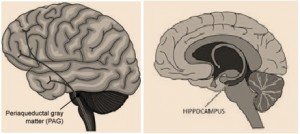Countless studies have demonstrated that patients’ beliefs and expectations can predict both therapeutic and adverse effects of any given drug or physical intervention.
This particular study also looked at brain imaging while they measured the pain tolerance of healthy volunteer college students.
These willing subjects were informed that the pain experiment involves a painful heat stimulation to their arm in addition to a powerful intravenous (IV) opioid. The volunteers also received fMRI during the time of receiving the painful stimuli in order to evaluate their brain activity.

The researchers assessed the effect of IV opioid on constant heat/thermal pain under three experimental conditions.
Condition 1: No expectation of analgesia
Condition 2: Expectation of analgesia
Condition 3: Expectation of hyperalgesia
In condition 1, the subjects were simply never told that the opioid IV drip had started (hidden analgesia), so they had no expectation of analgesia
In condition 2, the subjects were told that the opioid IV drip had just started (causing a positive expectation; even though the IV had already started without their knowledge)
In condition 3, they pretended that they stopped the opioid IV drip (but they actually had not … producing an expectation of hyperalgesia).
So what happened?
Condition 1: There was a small analgesic effect when the subjects were not even aware of the opioid injection …which makes sense.
Condition 2: The analgesic benefit of the opioid more than doubled when the subjects were made aware of the opioid injection and therefore had a positive treatment expectancy.
Condition 3: The analgesic benefit of the opioid was completely abolished when the subjects were falsely informed that the opioid injection had stopped and therefore had a negative treatment expectancy.
The results thus far should not surprise anyone but what is fascinating is that the fMRI showed that the positive expectancy effects were associated with activity in the endogenous pain modulatory system (e.g. periaqueductal gray (PAG)).
The negative expectancy effects were associated with activity in the hippocampus (a neural ‘amplifier’ of pain).

Basically, the PAG has the ability to double the analgesia provided by opioids and the Hippocampus has the ability to remove the potential analgesia provided by opioids.
This experiment should speak to all PTs by ensuring that we take the time to discuss with patients their condition, the suggested treatments and of course the positive expectations of treatment in a reasonable period.
Clinical relevance: Our goal as PTs is to always focus on maximizing patient expectations as this is clearly associated with activating the PAG endogenous opioid system. Therefore, the idea that placebo does not have “real” physiological effects is utterly false!
Reference: Bingel U, et al The effect of treatment expectation on drug efficacy: imaging the analgesic benefit of the opioid remifentanil. Sci Transl Med. 2011 Feb 16; 3(70):70ra14.

